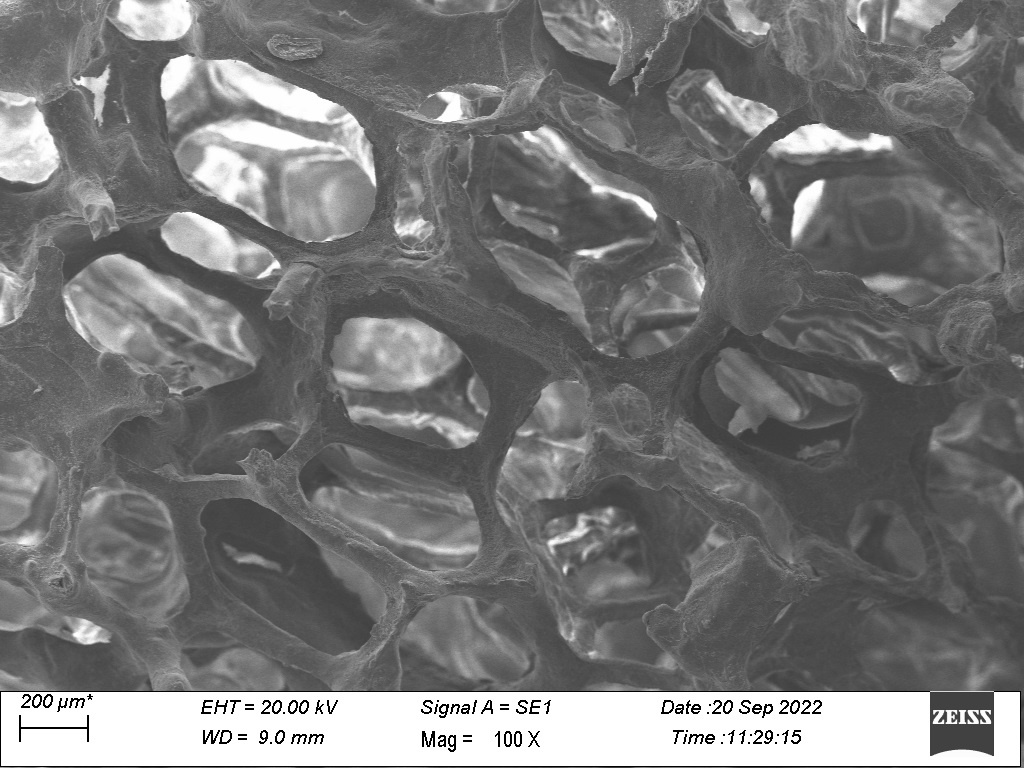

Ceramic foams are highly porous open-cell ceramic structures that exhibit very high porosities with good interconnectivity. Alpha-alumina based ceramic foam is produced via replica method, which involves coating of the polyurethane based polymer sponge with the α-alumina ceramic slurry followed by removal of excess slurry by squeezing, drying and sintering to remove the polymer components. This procedure results in a α-alumina ceramic replica of original polymer foam. This ceramic foam will provide macroporous support for the Pt-catalyst. But the surface area of α-alumina is typically not sufficient to deposit a catalytically active phase, therefore the α-alumina based macroporous support is coated with γ-alumina to enhance the surface area. Finally, the ceramic foam is impregnated with an aqueous solution of hexa-chloroplatinic acid followed by heat treatment resulting in formation of platinum nanoparticles.
Ceramic foams are highly porous open-cell ceramic structures that exhibit very high porosities with good interconnectivity. Alpha-alumina based ceramic foam is produced via replica method, which involves coating of the polyurethane based polymer sponge with the α-alumina ceramic slurry followed by removal of excess slurry by squeezing, drying and sintering to remove the polymer components. This procedure results in a α-alumina ceramic replica of original polymer foam. This ceramic foam will provide macroporous support for the Pt-catalyst. But the surface area of α-alumina is typically not sufficient to deposit a catalytically active phase, therefore the α-alumina based macroporous support is coated with γ-alumina to enhance the surface area. Finally, the ceramic foam is impregnated with an aqueous solution of hexa-chloroplatinic acid followed by heat treatment resulting in formation of platinum nanoparticles.
Due to special geometry and resulting properties of ceramic foams, they can be used in a wide range of engineering applications like include molten metal, hot gas and diesel exhaust filters, catalyst carriers, biomaterials, thermal insulators for furnaces and aerospace applications, gas combustion burners and lightweight materials. Alumina ceramic foam can be used as catalysts supports for industrial steam reforming processes and HI decomposition in I-S process of hydrogen production.
INTRODUCTION
Ceramic foams are highly porous open-cell ceramic structures that exhibit very high porosities with good interconnectivity. Alpha-alumina based ceramic foam is produced via replica method, which involves coating of the polyurethane based polymer sponge with the α-alumina ceramic slurry followed by removal of excess slurry by squeezing, drying and sintering to remove the polymer components. This procedure results in a α-alumina ceramic replica of original polymer foam. This ceramic foam will provide macroporous support for the Pt-catalyst. But the surface area of α-alumina is typically not sufficient to deposit a catalytically active phase, therefore the α-alumina based macroporous support is coated with γ-alumina to enhance the surface area. Finally, the ceramic foam is impregnated with an aqueous solution of hexa-chloroplatinic acid followed by heat treatment resulting in formation of platinum nanoparticles.
The process requires simple equipment such as decomposition furnaces, pressing equipment, sintering furnaces etc. The different process steps can be conducted using minimum manpower.
Due to special geometry and resulting properties of ceramic foams, they can be used in a wide range of engineering applications like include molten metal, hot gas and diesel exhaust filters, catalyst carriers, biomaterials, thermal insulators for furnaces and aerospace applications, gas combustion burners and lightweight materials. Alumina ceramic foam can be used as catalysts supports for industrial steam reforming processes and HI decomposition in I-S process of hydrogen production.
Alpha-alumina based ceramic foam is produced via replica method for the substrate. This alumina substrate is further coated with gamma-alumina to enhance the surface area. Finally, the ceramic foam is impregnated with an aqueous solution of hexa-chloroplatinic acid followed by heat treatment resulting in formation of platinum nanoparticles.
RAW MATERIALS
Alumina ceramic is commercially available and inexpensive material. Gamma Alumina and Chloroplatinic acid hexahydrate are also locally available material. Chloroplatinic acid hexahydrate is required for Platinum coating over Alumina foam. And polyurethane foam is template material commonly available in local market for packaging and cushion applications.
INFRASTRUCTURE
The major equipment required are Jar mill, Vacuum Impregnator, Oven, Resistance heating calcination furnace and High temperature resistance heating sintering furnace.
MANPOWER
The manpower requirements depend on the capacity and the extent of automation. 1 Graduate in chemical or ceramic engineering/post graduate in science & 2 skilled lab technicians are required to start the production.

